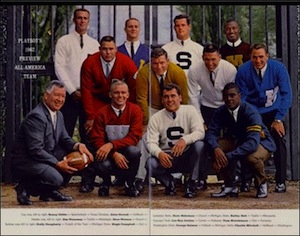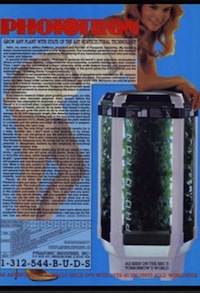Big Porno and California's pot prop
Exclusive: Judith Reisman shows link between Playboy, children, glorification of drugs
California's Prop. 19 would legalize recreational marijuana and open the floodgates nationwide to skyrocketing drug-abuse costs in lives and taxes.
The billion-dollar porn industry has long worked to legalize all illicit mind-altering drugs; a mindless polity is a slave polity, after all.
Hugh Hefner, (lionized now in a feature film, "Hugh Hefner: Playboy, Activist and Rebel") merged American sports heroes with images of child sex abuse, incest and prostitution beginning in 1954.
And, since 1968, Hefner, ("I'm Kinsey's pamphleteer") has promoted illicit drugs, financially supporting marijuana legalization since November 1970.
During my child-pornography study for the U.S. Justice Department, Juvenile Justice and Delinquency Prevention, we uncovered Hefner's exploitation of sports figures to market Kinseyan pansexuality. Below is a typical Playboy "All America Team" promotional, from the September 1962 issue:

In 1987, my colleague, psychiatrist and sports expert Dr. Linnea Smith, M.D., and I presented our findings ("Sports, Children, Drugs, Crime and Violence in Playboy Magazine") to the coaches of the National Collegiate Athletic Association.
Since then, several NCAA coaches and players refused to be included as one of Playboy's "All America Team."
Athletes are acknowledged as primary heroic role models for American youth. Any magazine that profiles prominent American athletes strongly influences juvenile males.
Although the systemic normalization of child sex abuse, sex trafficking (prostitution) and similar crimes is critical, our article briefly notes Hefner's clandestine illicit drug marketing to its vulnerable consumers.
Nearly every Playboy issue carries some article, interview, review, or reference to sports.
In 1970, Hefner's Playboy Foundation formally underwrote the creation of NORML (National Organization for the Repeal of Marijuana Laws), subsequently called the National Organization for the Reform of Marijuana Laws. Legalizing cocaine was put on the waiting list for later.
Most fraudulent promotions of illegal drugs appeared in "The Playboy Forum," "Forum Newsfront," letters to the editor, advice columns, interviews, jokes and film reviews.
Pro-drug images were in the form of colorful pop-up charts and games, especially designed to attract the juvenile consumer.
Others were in articles, colorful graphs, charts and slanted reports about why we need to legalize drugs.
Phototron
The Phototron (right), infamous for growing marijuana indoors to escape police detection, was regularly advertised in Playboy.
Pro-drug advocacy was juxtaposed with naked females, texts on sports figures and the "All-American Teams." An example of the magazine's deliberate merger of sports, illicit sex and drugs was the September 1978 issue.
Tomorrow's voters read a slanted story on the harmless fun of "Drugs '78" alongside 1) Playboy's "Pigskin Preview," 2) nude "Girls of the Pac 10" and 3) a rainbow-colored and detachable "Drug Centerfold" for fun and games.
In 1979, psychologist Aaron Hass identified Playboy as the major source of sex education for juveniles - for sex advice, values and mores ("Teenage Sexuality," 1979). Add illicit drugs to that "information."
For example, in May 1971 Playboy published a colorful cut-out drug game, with dice and a board called "Feds 'N Heads," especially appealing to children.
In August 1984, Hefner published a full-color page illustrating "The New Official Boy Scout Handbook" to "advance quickly in scouting." It stars a grinning adolescent boy who gets his "merit badge" for "freebasing" cocaine and for taking his "Johnny Walker straight up." Ho, ho, ho.
Our study defined these visuals as "Child Magnets."
You ask, has Playboy historically portrayed children - its future voters - with licit or illicit drugs?
Our content analysis of the magazine's photos and cartoons identified 5 percent associated with the use of drugs or alcohol. More than half of these child visuals included illegal drugs such as marijuana, cocaine, heroin and PCP, and 48 percent in this category were alcohol related.
Although Playboy has been identified in the sexual entrapment of children, its role in entrapping the Me Generation into illicit drug use is rarely understood. But as Playboy mixed drugs, sex, violence and children in its pictorial and text format, even Dr. Neil Malamuth, Communication Studies at UCLA, wrote: "The portrayal of sexual aggression within such 'legitimate' magazines as Playboy or Penthouse may have a greater impact than comparable portrayals in hard-core pornography" ("Pornography and Sexual Aggression," 1985, p. 42).
Certainly, the same "impact" applies to marketing illicit drugs to ease ones troubles - but how much? How much will the Nov. 2 votes on California's Prop. 19 - the "Regulate, Control and Tax Cannabis Act of 2010" - reflect this early, ongoing drug conditioning by "Kinsey's pamphleteer" and his cult?
Article copyrights are held solely by author.
[ Japan-Lifeissues.net ] [ OMI Japan/Korea ]